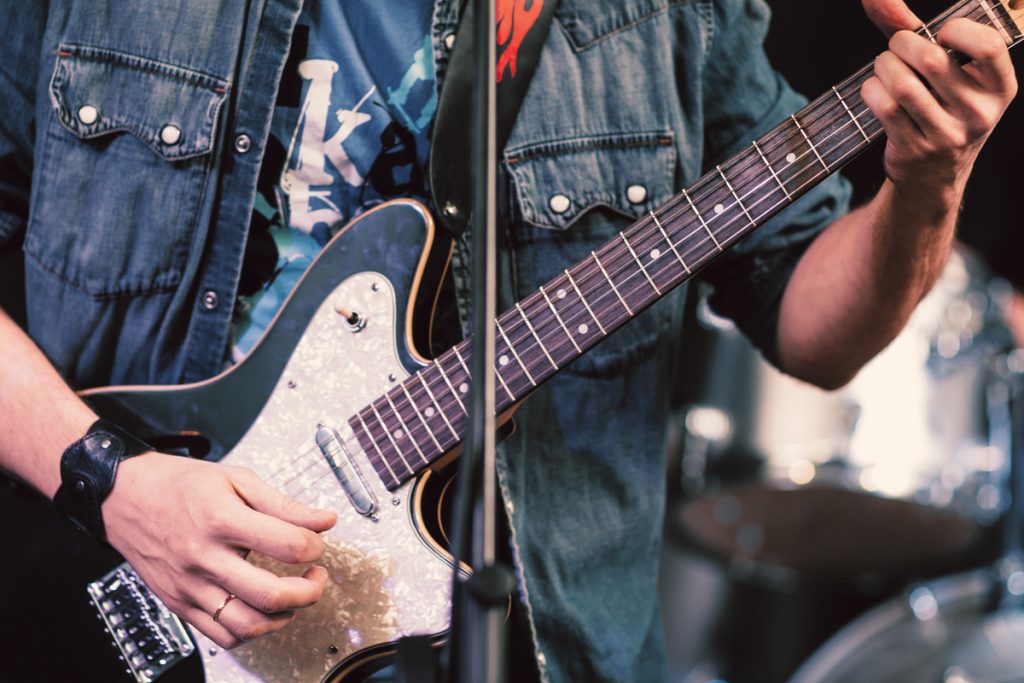Hailing from the Big Easy, Shane’s played with everyone from the Neville Brothers to Boz Scaggs to Dr. John to Jewel to Little Feat and the list goes on and on. While he’s a phenom lead player, it’s his rhythm chops that keep the phone ringing off the hook. Shane has organized the Rhythm Mojo curriculum in three sections; Section 1 covers 21 essential concepts and techniques, Section 2 presents 10 rhythm studies designed to help you learn how to apply those concepts and techniques, and Section 3 puts it all to work across a series of 6 playalongs, which will help you manifest your own special Rhythm Mojo. Give these lessons a taste to get your own mojo working.
Melodic Do-Dads
Download the tab, notation, and jam track for this rhythm lesson.
Sometimes a simple part is all you need. These melodic ideas work over a 1 to 6 minor progression and is based on a major pentatonic scale. You’ll find this to be a really useful lesson that will inspire you to come up with your own parts.
Open String Grooves
Download the tab, notation, and jam track for this rhythm lesson.
Now let’s look at a technique using an open string pull-off within a rhythm part. I was first exposed to this sound by Leo Nocentelli of the Meters and the song ‘Runnin’ Fast’. We’ll look at this sound and I’ll expand on it quite a bit in different keys.
Memphis Moves: Performance
Download the tab, notation, and jam track for this rhythm lesson.
This is a great feeling R&B soul progression that I’ll show how to apply the triads, doublestops and 3rds to Cropper, Curtis etc. Keep that driving pulse going around your fills to really make the track work.
Memphis Moves: Breakdown
Download the tab, notation, and jam track for this rhythm lesson.
The main point of this lesson is that sometimes it’s just in the right hand (or strumming hand). Note how I’m just using standard bar chords, nothing fancy here. The chunk on the bottom strings is the meat of the whole riff. Note the use of the 6th chord, this is a nice sub for a dominant 7th chord sometimes. The hammer-ons are classic and should be a point of study on their own. I also slide into the chords on the approach which makes it bounce a little more.
Auto-Wah Groove: Performance
Download the tab, notation, and jam track for this rhythm lesson.
Now I’ll show you how an effect like the auto wah can be used to spice up a part. Notice the way I use the pick and fingers to really get the most syncopation out of the part. This is also known as chicken pickin in country guitar technique.
Rhythm Mojo Groove 2: Playalong
Download the tab, notation, and jam track for this rhythm lesson.
Here’s a fun little 1, 4, 5 groove in a Cajun/Zydeco feel. Notice the way I use the 9th chords. I then move on to straight bar chords (Driving Rhythm) but slide into the chords (Slipping and Slidin). I use the concept again with some higher 7th voicings just after this. I then move on to using the triads over the 1, 4, 5 progression, then move on to a descending 3rds idea. Then I use the rockabilly idea from the Zydeco groove in an earlier example.
Rhythm Mojo Groove 6: Playalong
Download the tab, notation, and jam track for this rhythm lesson.
The last example is a “Neo- Soul” progression based on a previously used sequence – Amin7- Cmin7. This is a great one to practice voice leading and moving melodic ideas through 2 different key centers. I use several concepts – Breaking up the chord, Melodic Do Dads, 3rds, Wah-wah pedal. Notice the way I use the min 9 voicing later in the example and change one note to make the chord change – (voice leading). This is thinking like a keyboard player! I then play some muted funky 16 note idea which is another great effective part to use.
As you can see, there’s no tedious exercises or boring theory to struggle through in Rhythm Mojo — you will play your way through the entire course if you so desire. Everything is tabbed and notated, plus you’ll get all of the killer rhythm tracks to work with on your own. Check it out for even more…
